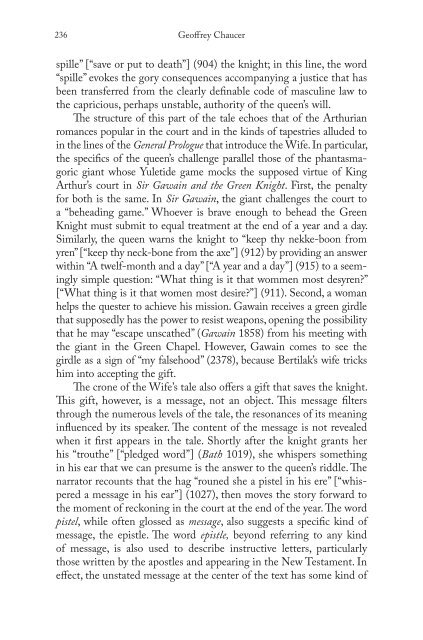Blooms Literary Themes - THE TRICKSTER.pdf - ymerleksi - home
Blooms Literary Themes - THE TRICKSTER.pdf - ymerleksi - home
Blooms Literary Themes - THE TRICKSTER.pdf - ymerleksi - home
Create successful ePaper yourself
Turn your PDF publications into a flip-book with our unique Google optimized e-Paper software.
236<br />
Geoff rey Chaucer<br />
spille” [“save or put to death”] (904) the knight; in this line, the word<br />
“spille” evokes the gory consequences accompanying a justice that has<br />
been transferred from the clearly defi nable code of masculine law to<br />
the capricious, perhaps unstable, authority of the queen’s will.<br />
Th e structure of this part of the tale echoes that of the Arthurian<br />
romances popular in the court and in the kinds of tapestries alluded to<br />
in the lines of the General Prologue that introduce the Wife. In particular,<br />
the specifi cs of the queen’s challenge parallel those of the phantasmagoric<br />
giant whose Yuletide game mocks the supposed virtue of King<br />
Arthur’s court in Sir Gawain and the Green Knight. First, the penalty<br />
for both is the same. In Sir Gawain, the giant challenges the court to<br />
a “beheading game.” Whoever is brave enough to behead the Green<br />
Knight must submit to equal treatment at the end of a year and a day.<br />
Similarly, the queen warns the knight to “keep thy nekke-boon from<br />
yren” [“keep thy neck-bone from the axe”] (912) by providing an answer<br />
within “A twelf-month and a day” [“A year and a day”] (915) to a seemingly<br />
simple question: “What thing is it that wommen most desyren?”<br />
[“What thing is it that women most desire?”] (911). Second, a woman<br />
helps the quester to achieve his mission. Gawain receives a green girdle<br />
that supposedly has the power to resist weapons, opening the possibility<br />
that he may “escape unscathed” (Gawain 1858) from his meeting with<br />
the giant in the Green Chapel. However, Gawain comes to see the<br />
girdle as a sign of “my falsehood” (2378), because Bertilak’s wife tricks<br />
him into accepting the gift.<br />
Th e crone of the Wife’s tale also off ers a gift that saves the knight.<br />
Th is gift, however, is a message, not an object. Th is message fi lters<br />
through the numerous levels of the tale, the resonances of its meaning<br />
infl uenced by its speaker. Th e content of the message is not revealed<br />
when it fi rst appears in the tale. Shortly after the knight grants her<br />
his “trouthe” [“pledged word”] (Bath 1019), she whispers something<br />
in his ear that we can presume is the answer to the queen’s riddle. Th e<br />
narrator recounts that the hag “rouned she a pistel in his ere” [“whispered<br />
a message in his ear”] (1027), then moves the story forward to<br />
the moment of reckoning in the court at the end of the year. Th e word<br />
pistel, while often glossed as message, also suggests a specifi c kind of<br />
message, the epistle. Th e word epistle, beyond referring to any kind<br />
of message, is also used to describe instructive letters, particularly<br />
those written by the apostles and appearing in the New Testament. In<br />
eff ect, the unstated message at the center of the text has some kind of

















